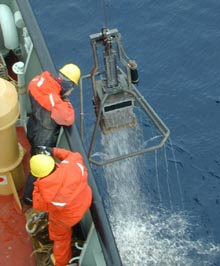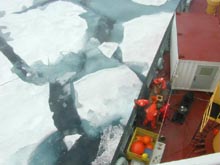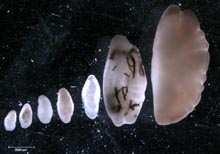
Benthic scientists hoped that the box core, lowered from the ship’s starboard side, would provide the backbone of data collected during the 4-wk expedition. (Photo courtesy Mike Vecchione, NOAA/Smithsonian Institution.) Click image for larger view.

Every box core required hours of sieving through the mud in search of both living and remnant life. Though their job appeared a bit tedious, the “mud people’s” jokes and lighthearted humor made finding volunteers to assist them quite easy. (Photo courtesy Mike Vecchione, NOAA/Smithsonian Institution.) Click image for larger view.
Highlights of Deep-sea Benthos Diversity and Food Web Structure
August 14 - September 8, 2002
Dr. Ian MacDonald
Texas A&M University
Dr. Bodil Bluhm, University of Alaska, Fairbanks
![]() View a slideshow of fish captured by the ROV's camera along the Arctic bottom. (mp4, 1.8 MB)
View a slideshow of fish captured by the ROV's camera along the Arctic bottom. (mp4, 1.8 MB)
![]() View a slideshow of invertebrates that live on the Arctic bottom. (mp4, 2.9 MB)
View a slideshow of invertebrates that live on the Arctic bottom. (mp4, 2.9 MB)
We completed a series of benthic stations across the Canada Basin finding noteworthy differences in the fauna, bottom types, and sediments within this domain. By combining box core sampling with detailed visual inspection and targeted collection with a remotely operated vehicle (ROV), we have obtained new insights into the geographic and topographic variability in benthic fauna. The benthic group found noteworthy differences in the fauna, bottom types, and sediments. As the findings are analyzed and interpreted, our results will refine the current view of an apparently impoverished Arctic deep-sea fauna, and offer insight into circulation patterns, slope transport, and climate processes.
We found that the numbers and biomass of the larger infauna (macrofauna) were very low compared to shallower areas, especially in the eastern part of the Canada Basin. The most abundant liffe forms in the sea-floor sediments were polychaetes, crustaceans, and bivalves. When we compared our preliminary results with the list of recovered fauna from the Eurasian Arctic deep sea, we found out that there were large similarities.
Box cores provide a sample of the organisms in the sediment as well as small animals on the sediment, and of the remains of life that has "rained down" to the sea floor. However, we also wanted to have a look at larger life forms thriving on and above the sea floor. The ROV was our tool for this effort. Even as early as our first dive, we discovered that the main fauna living on the sediments were crustaceans (shrimps, amphipods), fish, polychaetes (mobile in eastern Canadian basin, sessile in the western basin), anemones and tunicates (western basin).
We noticed some differences between the bottom environments in the western and eastern basin. The western slope was a higher-energy environment, where more rocks, more sand, and fewer animal tracks (lebensspuren) were found. In addition to the west slope station, we located more suspension feeders, many of which used rocks as a substrate for attachment.

These fish otoliths, small white structures found in the heads of fish, were collected from the box- core samples. Otoliths are not only important tools for understanding the life cycles of fish and fish populations, they may also provide a record for scientists of past water mass characteristics. (Photo courtesy Ian MacDonald, Texas A&M University.) Click image for larger view.
A very low-energy environment characterized the sea floor of the eastern side of the basin. Lebensspuren were everywhere in our video coverage there. The fact that the oceanography suggests that this water is very stable, and has not mixed for the last 500 yrs, makes us wonder whether these animal tracks on the sea floor are recent or ancient.
On the Northwind Ridge slope, at a depth of 2,000 m, we sampled large quantities of earbones from fish (otoliths). Why had they accumulated here? Other dead remnants, such as bivalve, gastropod and scaphopod shells were also recovered. These accumulations are consistent with information suggesting that this region is a frontal boundary between water masses of Pacific and Atlantic origin. The collection is also noteworthy because of the possibility that the calcareous remains can be carbon dated and analyzed for 18O. If this proves possible, the collection could provide a record of water mass characteristics during recent geologic time.
Identification of the specimens collected and photographed during the cruise will require additional sample processing, a review of the photographic material, assistance from experts, and a careful review of literature. A rich set of observations on deep benthic fishes was assembled during this cruise; efforts will be made to coordinate with the systematic ichthyology community to identify the species observed. The results of this cruise will certainly become a worthwhile contribution to the literature, because so little information on these communities exists.
Sign up for the Ocean Explorer E-mail Update List.


























